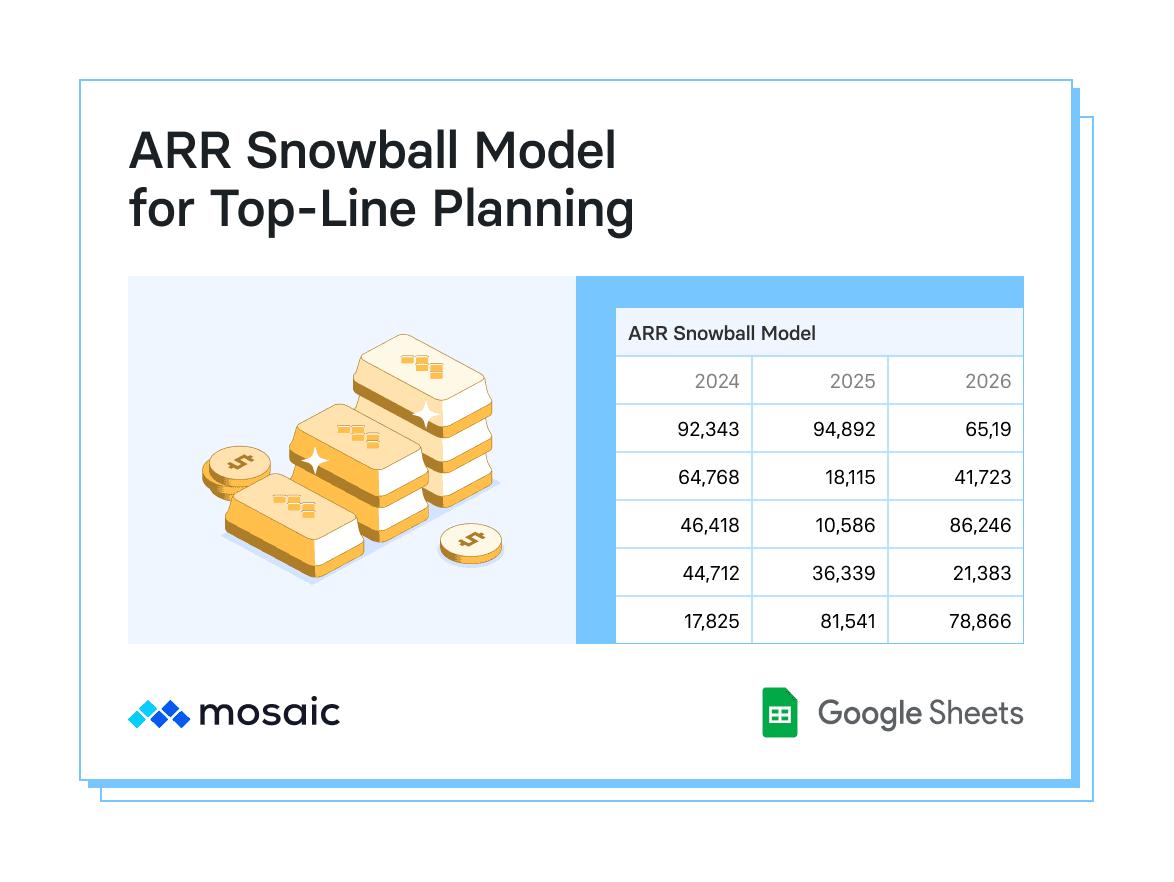Attracting and retaining customers is the heart of your success when your business operates on a subscription model. And the best way to do that is by studying and understanding your business’s key revenue drivers.
What’s more, implementing a driver-based approach in strategic planning, forecasting, and budgeting can enhance your team’s agility and overall performance. But the catch here is that those revenue models must be constructed to integrate drivers and assumptions cohesively.
Table of Contents
What Are Revenue Drivers?
Revenue drivers are the operational levers associated with products, services, markets, and activities that generate income for a business. In other words, revenue drivers are about where and how your business creates cash flow. It’s the difference between
- Expecting 12% MoM revenue growth and
- Expecting 12% MoM revenue growth by performing specific actions.
In contrast to assumptions, drivers are more flexible and can be adjusted as needed. They serve as adaptable inputs for the model, allowing you to push and pull them like levers to impact business performance outcomes.
Your team’s understanding of your primary revenue drivers should drive your business decisions and is the key to developing strong and flexible financial models. SaaS companies need both, as agility is key to any startup’s survival, both long and short-term.
ARR Snowball Model for Top-Line Planning

Revenue Driver Characteristics
Effective revenue drivers — especially for forecasting — have two main characteristics. First, they are controllable. Driver inputs should be easily increased or decreased with a high level of certainty in scenario analysis. Sales headcount is a prime example of a controllable value. By factoring in their ramp rate, you can estimate when improvements in sales pipeline metrics can be expected.
Second, they should have minimal diminishing returns to scale proportionally with your business. Continuing with the same example, each additional sales headcount should consistently drive higher revenue.
The Types of Revenue Drivers (with Common Examples)
Generally, we break revenue drivers (no matter the revenue stream) into two categories: marketing and sales. Marketing revenue drivers invite customers to your business. Examples include SEO content, social media ads, paid search, media buys, and other marketing spending.
Sales volume drives revenue because they directly contribute to topline growth. Activities include everything your sales team does to bring in new business: cold calling, demos, and more.
Incorporating revenue drivers into your business model enhances flexibility and influence over your expansion strategies. Let’s take a closer look at some of the specific actions within each category of revenue driver.
Marketing Revenue Drivers
Marketing revenue drivers drive growth by increasing customer acquisition, retention, and satisfaction. It’s also where you can increase the lifetime value of your customers. Marketing departments do this through a range of inbound and outbound marketing tactics. Luckily, that spending can often be translated into results by digging deep into how well marketing efforts convert strangers into leads.
Below are a few of the highest-value revenue drivers your marketing department can deploy. Each has its place within your strategy, but some may be more appropriate than others depending on your budget, headcount, and maturity.
Search Engine Optimization (SEO)
Often the heart of inbound marketing, SEO is the process of optimizing your website for people and search engines so that readers find your content. Producing strong, evergreen content is an incredible way to drive traffic and leads to your website (and your sales team), as publishing a page once (and updating it occasionally) can bring in leads for years.
Better yet, build a blog that becomes known for its helpful, thought-leading content, and you’ll build a readership of devotees willing to share your content everywhere. The downside here is that SEO takes time. Young startups should start building their inbound library. But often find it helpful to incorporate paid search into their strategy.
Pay-Per-Click (PPC) Advertising
PPC is an outbound marketing tactic. This includes display ads on search engine results pages (SERPs) and elsewhere, such as a blog. This is a great way to target your audience using specific keywords and demographics.
For example, if you offer a product that would benefit people searching for a high-volume, highly competitive keyword, you can purchase a place on the SERP. While paid search positions do not typically yield as many clicks as landing within the top results of the SERP, it’s still a highly effective way to draw in new business when done well.
Email Marketing
Email marketing is all about nurturing your leads and current customers. There’s a lot you can do here to add to top-line growth. Your marketing team can create several email sequences that can provide different experiences for your customers.
You can have an onboarding sequence that ensures customers feel welcomed and know how to use your product(s). You can also have a sequence that promotes upselling and cross-selling products. Here, you can also promote referral programs to convert customers into ambassadors.
But it’s not just your customers who will sign up for emails. Your prospective customers may also want to engage with your newsletters. So this is a great opportunity to nurture leads and uncover effective ways to convert them into customers.
Social Media Marketing
Like a company blog, your social media accounts can drive traffic to your website and into your sales funnel. You can also advertise on social media and work with influencers to promote your products. It’s also an excellent place for social listening, which your team can use to improve future product versions.
Sales Revenue Drivers
Your sales team is the one-to-one relationship that brings new customers to your business. Enhancing the efficiency and effectiveness of the sales process, increasing productivity, and improving lead conversion rates are the heart of your sales revenue drivers. And there are a few ways to think about the “levers” of sales drivers.
Below, we’ve boiled these concepts down into three categories where your team can benchmark and tinker with to create a range of scenarios for planning.
Sales Capacity Model for Top-Line Planning
Sales Team Performance
This is where you consider the efficacy of your sales team in turning leads into customers. The structure of your sales team can affect outcomes here, so it may be good to consider multiple possibilities. For example, what if your team becomes less efficient because you’re onboarding many new people?
Here is where you might also consider how sales automation can improve efficiency. By automating repetitive or time-consuming tasks such as lead generation, lead nurturing, follow-up emails, and scheduling, sales representatives can spend more time on high-value activities such as closing deals and building relationships with prospects and customers. All of which contribute heavily to topline growth.
Sales Headcount and Ramp Time
If your business plans to grow, your team will probably plan to onboard new salespeople. This is where headcount planning meets ramp time. Remember that not every sales associate will ramp at the same rate, so consider a range of possibilities when planning. You should also consider things like attrition and plan for multiple scenarios.
Pricing and Packaging Strategies
How you price your products or what you include with your subscription alters how your sales team sells. So this is also an excellent time to consider how introducing different prices or packages can affect the effectiveness of your sales team.
Mosaic Helps SaaS Businesses Plan Around Their Money Makers
Mosaic’s dashboards allow your team to go beyond balance sheets and financial statements. Our tools make it much easier for your team to
- Identify critical revenue drivers.
- Track and report on those drivers.
- Use the results to inform future decision-making.
The real-time visibility into financial data enables teams to track key performance indicators (KPIs) and metrics, and identify trends that most directly impact revenue drivers. Our plug-and-play dashboard templates make it easy to set up and start identifying which activities are most effective. All you need to do is adjust your strategy accordingly.
Driver-based planning is traditionally quite difficult. But our tools simplify the process, allowing teams to easily forecast based on website traffic, customer acquisition rates, and even pricing changes.
Even better, our tools enable flexible financial modeling that can be adjusted and updated in real time. Responding to changes — or mistakes in previous revenue forecasting — usually takes a ton of time. But with our tools, it’s as easy as identifying, ideating, and adjusting.
Finally, with robust reporting and analysis tools, your team can track and analyze drivers month over month and year over year. Your insights and knowledge will stack, driving future growth to the moon.
To learn more, request a personalized demo and begin your journey to agile financial planning.
Revenue Driver FAQs
What is a cost driver?
Cost drivers are any action, process, or need that directly induces a cost. SaaS cost drivers include everything from labor to hosting services to the cost of utilities at the office. But the focus is on the activity that directly impacts costs. Hosting costs, for example, may be driven by the complexity of your product and the size of your customer base.
Is a profit driver the same as a revenue driver?
How do you determine revenue drivers?
How do I pitch my revenue drivers to stakeholders and investors?
Own the of your business.



